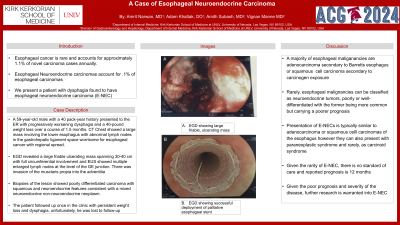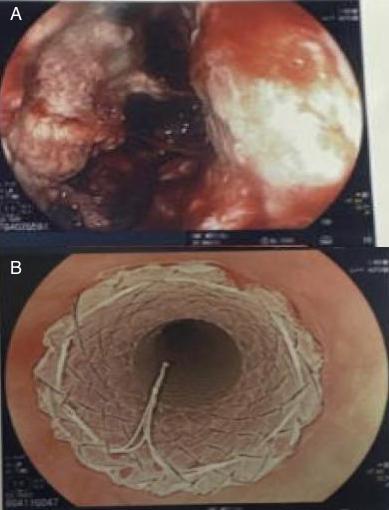Tuesday Poster Session
Category: Biliary/Pancreas
P3522 - A Case of Neuroendocrine Esophageal Carcinoma
Tuesday, October 29, 2024
10:30 AM - 4:00 PM ET
Location: Exhibit Hall E

Has Audio

Amrit Narwan, MD
Kirk Kerkorian School of Medicine at the University of Nevada
Las Vegas, NV
Presenting Author(s)
Amrit Narwan, MD1, Adam Khattak, DO1, Amith Subhash, MD1, Vignan Manne, MD2
1Kirk Kerkorian School of Medicine at the University of Nevada, Las Vegas, NV; 2Kirk Kirkorian School of Medicine, Las Vegas, NV
Introduction: Esophageal cancer is rare, accounting for approximately 1.1% of novel carcinoma cases
annually. It is largely subdivided into adenocarcinomas or squamous cell carcinomas with the
former being the most common subtype. Other rare subtypes of
esophageal cancers include neuroendocrine tumors accounting for less than 0.1% of
esophageal malignancies. Here, we report a case of a patient presenting with progressive
dysphagia found to have esophageal neuroendocrine carcinoma (E-NEC).
Case Description/Methods: A 59-year-old male with a 40 pack-year tobacco use history presented to the emergency
department with progressively worsening dysphagia and reported 40 pound weight loss over a
course of 6 weeks. Computed tomography of the chest showed a large mass involving the
lower esophagus with abnormal lymph nodes in the gastrohepatic ligament space worrisome for
esophageal cancer with regional spread. Esophagogastroduodenoscopy revealed a large friable
ulcerating mass spanning 10cm with full circumferential involvement causing partial luminal
obstruction. Endoscopic ultrasound revealed multiple enlarged regional lymph nodes along the
gastrohepatic ligament as well as mass invasion through the submucosa into the muscularis
propria. Biopsies of the lesion showed poorly differentiated carcinoma with squamous and
neuroendocrine features consistent with a mixed neuroendocrine and non-neuroendocrine
neoplasm. A palliative esophageal stent was successful deployed. Following discharge, the patient
was lost to follow-up.
Discussion: Esophageal adenocarcinoma secondary to Barrett's esophagus and squamous cell
carcinoma due to carcinogen exposure occupy the majority of esophageal malignancy
diagnoses. A rare subset known as E-NEC is classified as poorly or well-differentiated with the
former being more common and carrying a poorer prognosis. Patients can also present with
paraneoplastic syndromes and, rarely, carcinoid syndrome. Poorly differentiated E-NEC
commonly presents with lymph node involvement, distant metastases, and has a reported
prognosis of about 12 months. Due to the rarity of E-NEC, treatment options are limited to non-
standardized chemotherapy, radiation and surgical resection. Given the increasing prevalence
and incidence of esophageal cancers, further research into E-NECs is warranted to standardize
and explore treatment options as current median survival rates are less than ideal.

Disclosures:
Amrit Narwan, MD1, Adam Khattak, DO1, Amith Subhash, MD1, Vignan Manne, MD2. P3522 - A Case of Neuroendocrine Esophageal Carcinoma, ACG 2024 Annual Scientific Meeting Abstracts. Philadelphia, PA: American College of Gastroenterology.
1Kirk Kerkorian School of Medicine at the University of Nevada, Las Vegas, NV; 2Kirk Kirkorian School of Medicine, Las Vegas, NV
Introduction: Esophageal cancer is rare, accounting for approximately 1.1% of novel carcinoma cases
annually. It is largely subdivided into adenocarcinomas or squamous cell carcinomas with the
former being the most common subtype. Other rare subtypes of
esophageal cancers include neuroendocrine tumors accounting for less than 0.1% of
esophageal malignancies. Here, we report a case of a patient presenting with progressive
dysphagia found to have esophageal neuroendocrine carcinoma (E-NEC).
Case Description/Methods: A 59-year-old male with a 40 pack-year tobacco use history presented to the emergency
department with progressively worsening dysphagia and reported 40 pound weight loss over a
course of 6 weeks. Computed tomography of the chest showed a large mass involving the
lower esophagus with abnormal lymph nodes in the gastrohepatic ligament space worrisome for
esophageal cancer with regional spread. Esophagogastroduodenoscopy revealed a large friable
ulcerating mass spanning 10cm with full circumferential involvement causing partial luminal
obstruction. Endoscopic ultrasound revealed multiple enlarged regional lymph nodes along the
gastrohepatic ligament as well as mass invasion through the submucosa into the muscularis
propria. Biopsies of the lesion showed poorly differentiated carcinoma with squamous and
neuroendocrine features consistent with a mixed neuroendocrine and non-neuroendocrine
neoplasm. A palliative esophageal stent was successful deployed. Following discharge, the patient
was lost to follow-up.
Discussion: Esophageal adenocarcinoma secondary to Barrett's esophagus and squamous cell
carcinoma due to carcinogen exposure occupy the majority of esophageal malignancy
diagnoses. A rare subset known as E-NEC is classified as poorly or well-differentiated with the
former being more common and carrying a poorer prognosis. Patients can also present with
paraneoplastic syndromes and, rarely, carcinoid syndrome. Poorly differentiated E-NEC
commonly presents with lymph node involvement, distant metastases, and has a reported
prognosis of about 12 months. Due to the rarity of E-NEC, treatment options are limited to non-
standardized chemotherapy, radiation and surgical resection. Given the increasing prevalence
and incidence of esophageal cancers, further research into E-NECs is warranted to standardize
and explore treatment options as current median survival rates are less than ideal.

Figure: Esophagogastroduodenoscopy images:
A- EGD showing a 10 cm friable, ulcerating mass;
B- EGD showing successful deployment of palliative esophageal stent
A- EGD showing a 10 cm friable, ulcerating mass;
B- EGD showing successful deployment of palliative esophageal stent
Disclosures:
Amrit Narwan indicated no relevant financial relationships.
Adam Khattak indicated no relevant financial relationships.
Amith Subhash indicated no relevant financial relationships.
Vignan Manne indicated no relevant financial relationships.
Amrit Narwan, MD1, Adam Khattak, DO1, Amith Subhash, MD1, Vignan Manne, MD2. P3522 - A Case of Neuroendocrine Esophageal Carcinoma, ACG 2024 Annual Scientific Meeting Abstracts. Philadelphia, PA: American College of Gastroenterology.
